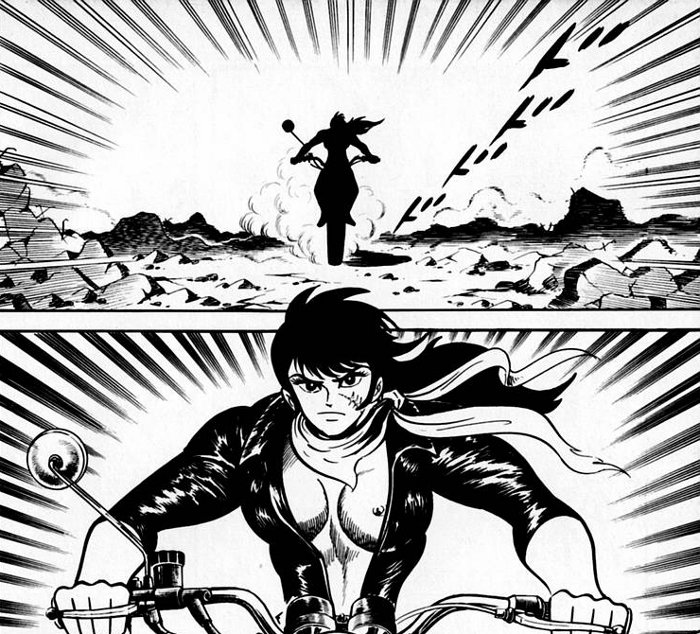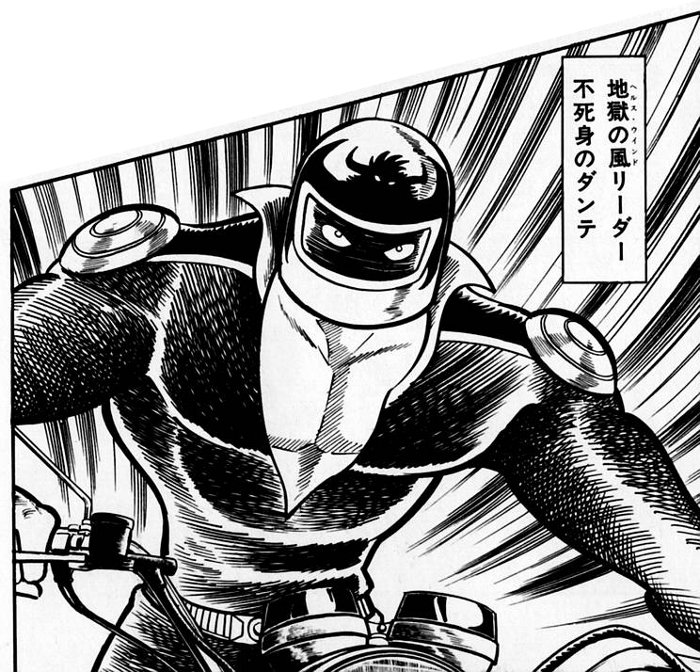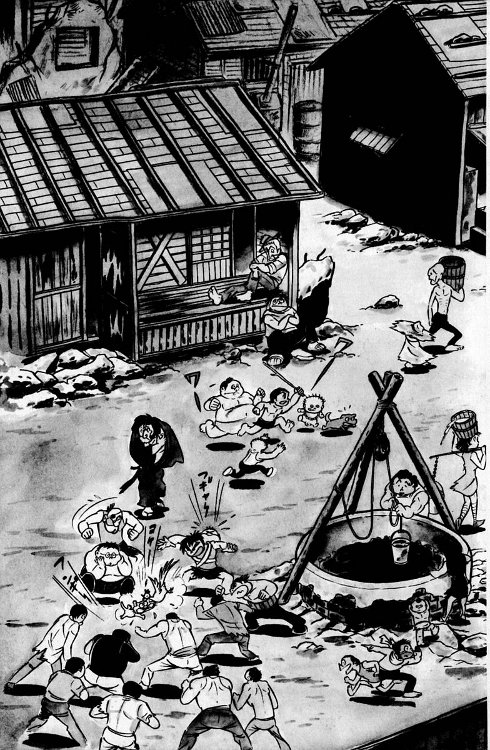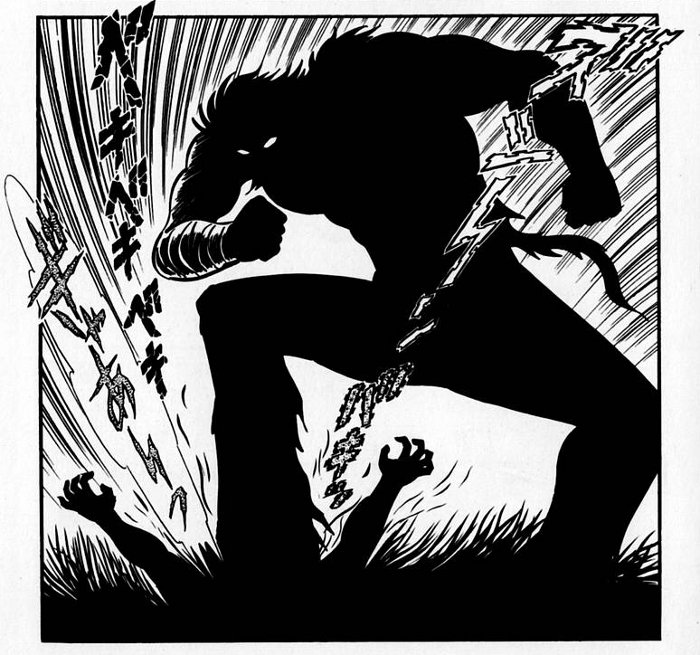OK, now we’re getting to what Violence Jack is all about.
Violence. Sadism. Nudity. And full on, gratuitous… references to other Go Nagai properties.

Pictured above is our heroine for this chapter, who Great Mazinger fans may recognise as Jun Hono, the female lead from that series. Her boyfriend we see in the flashback to pre-Earthquake times is Tetsuya Tsurugi, Great Mazinger’s hero and pilot. Jun Hono also gets the “re-imagining” treatment again Mazinger Angels, Nagai and Akihiko Nina’s mecha parody of Charlie’s Angels starring the female leads from Mazinger Z, Great Mazinger and Grandizer.
Also, according to wikipedia, there are also references to Mao Dante. Those are harder to place, certainly compared to the more obvious use of Mao Dante we shall see in the 80’s run. Possibly the Hell’s Wind biker gang are supposed to be the commandos who attack the sacrifice that summons Dante? Is the teacher character based on Saori, Mao Dante’s female lead? If anyone can clear that up for me, that’d be great. The only thing I’m certain of is that the lead biker has a Mao Dante-esque design painted on his helmet.

Something I forgot to mention in the last chapter is there’s another element of storytelling that appears in these late 70s stories that wasn’t really there in the early 70s stories. Namely, what wrestling nerds might call the “SANDMAN RUN-IN”. That’s reference to the ECW wrestler who’d make run-ins to save various babyfaces, but because he’d take so long to get to the ring, the heels would invariably be able to beat up the people he was trying to save for about more five minutes.
Violence Jack pretty much does this all the time from here on out. There’s always plenty of time for the villains to do something horrible to someone who doesn’t deserve it before Jack shows up to save them.
The story starts pre-Great Kanto Earthquake where we see our heroine for this chapter, Jun Hono out on a date with Tetsuya Tsurugi, when they are chased by the eponymous biker gang “Hell’s Wind”, causing them to have a crash that kills Tetsuya.
Then later while out riding her own motorcycle, the Earthquake hits, and we get a great sequence of Jun trying to outrace nature. The cartooning here is back to Nagai’s best, it’s hard to believe that the same artist drew this arc as the last. Skip to “now”, where we meet a scarred and tough Jun, still riding her bike, now through the wasteland of post-Earthquake Japan.
Then we get to meet this chapter’s victims!

A peaceful village, and in particular the local teacher. In spite of the apocalyptic landscape, the village is fairly serene, a long way from the Slum King’s Kanto Slums of the second story. Well until the bikers show up and start murdering folks before taking a bunch of hostages.
Jun then makes her Sandman run-in and starts to kill the bikers in return, first by arrows tipped with dynamite, then by machine gun and finally by revolvers, which for some reason requires Jun to take her top off before she can unholster. I’m sure that was entirely necessary. Jack also shows up, but fares worse than Jun, getting lanced in the chest by the gang leader, before being gunned down and left for dead.

The remaining bikers flee, but take the village teacher hostage. Jack’s recuperating, so Jun chases after them, only to get caught herself. Which leads to this chapter’s bondage scene. You know I might be jumping to conclusions, but I get the feeling Go Nagai really likes bondage, after all even Mazinger found itself tied to a crucifix at one point. This scene edges up the risque nature of the series, but there’s still none of the explicity sexual content associated with the name Violence Jack.
Of course, before the villains can do anything truly evil to our heroines, the villagers drag Jack to the bikers camp and the inevitable happens.

This is one of the stories that was adapted into an OAV. The anime loses a lot of the Nagai character design charm, and ups the sexual violence. However there’s another change which bothered me more than the mutilation and abuse that Jun suffers, and that’s the villagers blaming her, to her face, for increasing the carnage the biker gang caused by fighting back. That’s not a scene that appears in the manga, and she manages to extract some degree of revenge for Tetsuya and the village before getting captured. She definitely comes across stronger as a heroine in the manga, whereas she feels more like a victim in the anime.
The art was much improved in this story over the last, with some inspired layouts and a lot of personality to the villagers and the bikers. It’s worth noting that despite it’s resemblance to Mad Max, this particular story started in 1977, two years before Mad Max was released. More likely they were both tapping into the trend of revenge fiction popular in the 70s (this and the last story play much more like revenge tales compared to the first two), along with a degree of influence from westerns (and in the case of Violence Jack, samurai fiction).
Finally, this isn’t the last we shall see of Jun, she appears again the 7th story and she may appear again as another character in the 80’s incarnation, but more on that later when we get to the most confusing aspect of the series for me. OK I just re-read the next two stories. It starts to get confusing in the next chapter.
You know, Nagai’s older stories are still extremely violent, but because of his old style they look so cartoony, yet it’s quite effective. It’s an odd juxtaposition because his characters are usually quite grotesque, and I can still take it a lot more seriously than the likes of Elfen Lied, which is completely uninspired.